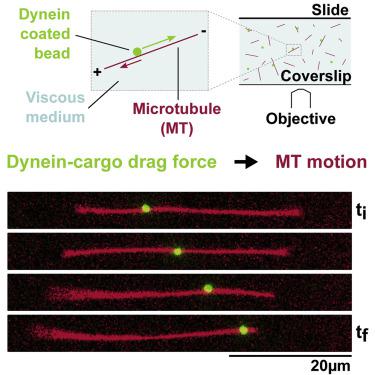Current Biology ( IF 9.2 ) Pub Date : 2020-09-17 , DOI: 10.1016/j.cub.2020.08.078 Héliciane Palenzuela 1 , Benjamin Lacroix 1 , Jérémy Sallé 1 , Katsuhiko Minami 2 , Tomohiro Shima 2 , Antoine Jegou 1 , Guillaume Romet-Lemonne 1 , Nicolas Minc 1

|
The forces generated by microtubules (MTs) and their associated motors orchestrate essential cellular processes ranging from vesicular trafficking to centrosome positioning [1, 2]. To date, most studies have focused on MT force exertion by motors anchored to a static surface, such as the cell cortex in vivo or glass surfaces in vitro [2, 3, 4]. However, motors also transport large cargos and endomembrane networks, whose hydrodynamic interactions with the viscous cytoplasm should generate sizable forces in bulk. Such forces may contribute to MT aster centration, organization, and orientation [5, 6, 7, 8, 9, 10, 11, 12, 13, 14] but have yet to be evidenced and studied in a minimal reconstituted system. By developing a bulk motility assay, based on stabilized MTs and dynein-coated beads freely floating in a viscous medium away from any surface, we demonstrate that the motion of a cargo exerts a pulling force on the MT and propels it in opposite direction. Quantification of resulting MT movements for different motors, motor velocities, over a range of cargo sizes and medium viscosities shows that the efficiency of this mechanism is primarily determined by cargo size and MT length. Forces exerted by cargos are additive, allowing us to recapitulate tug-of-war situations or bi-dimensional motions of minimal asters. These data also reveal unappreciated effects of the nature of viscous crowders and hydrodynamic interactions between cargos and MTs, likely relevant to understand this mode of force exertion in living cells. This study reinforces the notion that endomembrane transport can exert significant forces on MTs.
中文翻译:

在大块粘性介质中体外重建动力蛋白力。
微管 (MT) 及其相关马达产生的力协调从囊泡运输到中心体定位的基本细胞过程 [1, 2]。迄今为止,大多数研究都集中在固定在静态表面(例如体内的细胞皮层或体外的玻璃表面)上的马达施加的 MT 力[2, 3, 4]。然而,马达还运输大型货物和内膜网络,它们与粘性细胞质的流体动力学相互作用应该会产生相当大的力。这些力可能有助于 MT 星的中心、组织和方向 [5, 6, 7, 8, 9, 10, 11, 12, 13, 14],但尚未在最小重组系统中得到证实和研究。通过开发基于稳定的 MT 和动力蛋白包被的珠子在远离任何表面的粘性介质中自由漂浮的大量运动测定,我们证明了货物的运动对 MT 施加拉力并推动它向相反的方向前进。对不同电机、电机速度、货物尺寸和中等粘度范围内产生的 MT 运动的量化表明,该机制的效率主要取决于货物尺寸和 MT 长度。货物施加的力是可加的,使我们能够重现拔河情况或最小紫苑的二维运动。这些数据还揭示了粘性拥挤物的性质以及货物和 MT 之间的流体动力学相互作用的未被重视的影响,这可能与了解这种在活细胞中施加力的模式有关。这项研究强化了内膜运输可以对 MT 施加显着力量的观点。



























 京公网安备 11010802027423号
京公网安备 11010802027423号